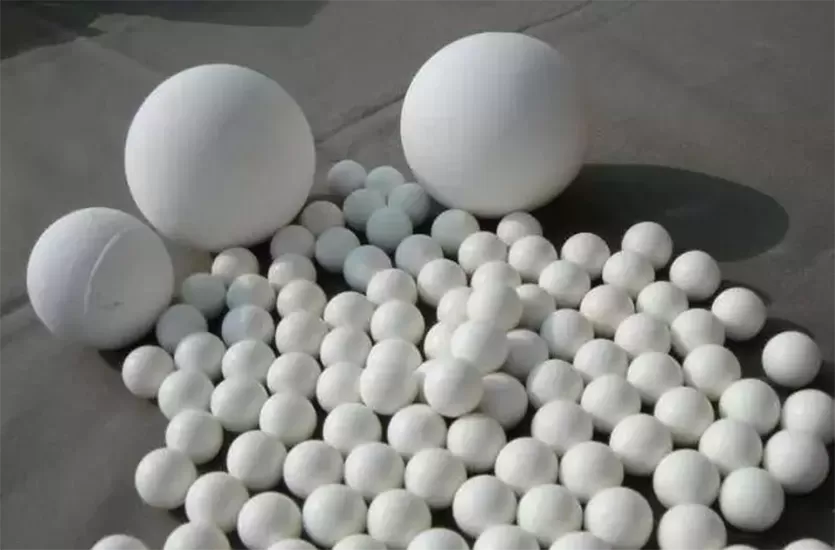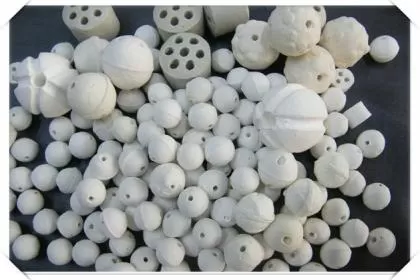
Alumina Ceramic Ball
Alumina ceramic balls are ceramic fillers mainly composed of alumina (Al₂O₃), and are widely used in petrochemicals, fertilizer production, natural gas purification, and environmental protection fields. This product is manufactured through high-temperature calcination or isostatic pressing processes and has characteristics such as high temperature resistance (up to 1790°C), resistance to acid and alkali corrosion (acid resistance ≥ 98.5%), and high mechanical strength (maximum compressive strength 40 kN per ball). According to the content of alumina, they can be classified into feldspar type (15%-30% Al₂O₃), mullite type (45%-70% Al₂O₃), corundum type (≥90% Al₂O₃), etc., and various structural forms such as open pores, concave-convex, and micropores are derived, which can meet the catalyst support and tower packing requirements of different reactors. In 2024, related patent technology achieved automated blanking grinding, and the production efficiency was increased to 80 balls per hour.

Porous Ceramic Ball
Porous ceramic balls are spherical ceramic materials with rich pore structures, and their structure has various advantages.
Higher specific surface area: The porous ceramic balls have a large number of micropores and mesopores, which significantly increases their specific surface area. A larger specific surface area means they have stronger adsorption capacity and catalytic activity. In the field of adsorption, it can more efficiently adsorb impurities in various gases and liquids, such as in waste gas treatment, it can adsorb harmful gases and purify the air. In catalytic reactions, it can provide more active sites for the catalyst, accelerating the reaction rate and improving the reaction efficiency.
High porosity: The porosity of porous ceramic balls is usually high. These pores are interconnected, forming excellent channels. This structural feature gives it excellent air permeability and water permeability. In the field of filtration, it can be used for the filtration of liquids and gases, allowing fluids to pass through smoothly while effectively intercepting impurities and particles. For example, in water treatment, it can filter out suspended solids, bacteria, etc., ensuring the purity of water quality.
High mechanical strength: Although the porous ceramic balls have a porous structure, they still possess high mechanical strength. This is because the unique microstructure combined with the properties of the ceramic material. In practical applications, they can withstand certain pressures and impacts, and are not prone to breaking or deforming. Whether in packed bed reactors or in filtration devices, they can function stably and have a long service life.

Ceramic Grinding Ball
Zirconia Ball: 65% zirconia ball, 80% zirconia ball, 95% zirconia ball
Zircon beads are the media used for material grinding in grinding machinery. According to the content of zirconium oxide, they can be divided into two types: 65 zircon beads (silicate zircon beads) and 95 zircon beads (high-purity zirconium oxide beads). The 65 zircon beads have a density of 4.0 g/cm³ and are suitable for ordinary industrial fields such as pesticides, paints, and coatings; the 95 zircon beads have a density of 6.0 g/cm³ and have low wear characteristics, and are specifically used in high-precision grinding scenarios such as electronic ceramics, medicine, and food. The two types of zircon beads achieve material grinding through rolling friction, and their physical properties directly affect the grinding efficiency and the particle size of the finished product.
Alumina Ball: 99% alumina ball, 99.9% alumina ball, 99.99% alumina ball
High-purity alumina balls usually refer to spherical particles with extremely high alumina content. Their purity generally reaches over 99%, and some products even reach 99.99% or higher. This material has a regular shape, less specific surface area, higher packing density and good fluidity, which can greatly improve the application performance of the products.


.jpg)
.jpg)
.jpg)
.jpg)
.jpg)
.png)
.jpg)
.jpg)
.jpg)